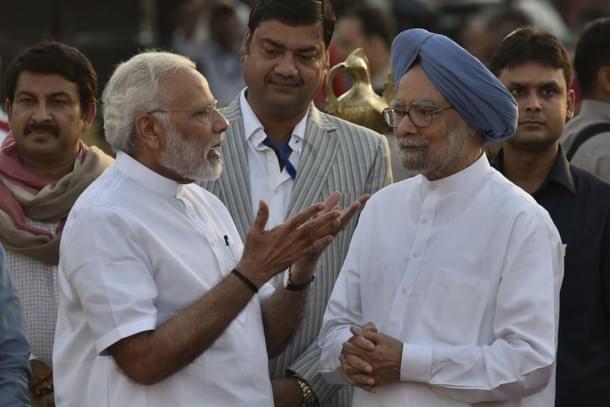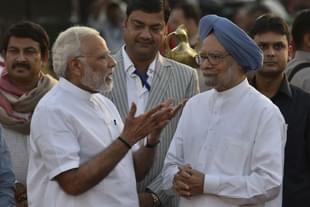Economy
Conflicting GDP Data: Lesson For Both UPA And NDA Is To Stop Gloating Over Growth, Focus On Jobs
R Jagannathan
Nov 29, 2018, 11:46 AM | Updated 11:42 AM IST
Save & read from anywhere!
Bookmark stories for easy access on any device or the Swarajya app.


The my-growth-is-bigger-than-yours claims made by Bharatiya Janata Party (BJP) and the Congress over the new back series on gross domestic product (GDP) data for the United Progressive Alliance (UPA) years is wholly unnecessary. While the Congress can surely cry foul over the fact that the new GDP figures for the UPA years (2004-14) show average growth to be lower than in the last four years of National Democratic Alliance-2 (NDA-2) under Narendra Modi, the BJP has no reason to pat itself on the back for the new numbers either. Old growth data, driven by changes in the methodology, do not change ground realities like the double balance-sheet problem, poor export growth, or weak capital investment.
In August, “experimental results” of the back series released for the 2005-12 period by the Ministry of Statistics and Programme Implementation (MOSPI) showed that GDP growth topped 9 per cent in four years of the UPA. In 2006-07, growth even reached double-digits.
In the latest official back series, evolved after expert deliberation over various aspects of the methodology to be adopted, UPA period growth falls from the 7.75 per cent calculated earlier in August to 6.82 per cent, while the NDA’s four years are shown as 7.35 per cent. The new GDP series was adopted with 2010-11 as base year.
Put simply, the Congress is yelling blue murder because the second and revised back series shows that growth did not cross 9 per cent in any UPA year, leave alone double-digits. UPA growth was highest in 2010-11 at 8.5 per cent, when the economy was on steroids due to the post-Lehman stimulus (excise and service tax cuts) provided by the government. This stimulus later led to high inflation and a sharp deceleration in growth as the fiscal and current account deficits went out of control.
Just as the UPA’s economic mismanagement led to high inflation and careening fiscal deficits, the NDA’s own contribution to GDP growth cannot be seen as a great success, for the double balance-sheet problem remains, and several sectors, from banks to NBFCs to telecom and aviation, are in serious trouble. The NDA’s real success has been on the inflation and fiscal consolidation front, but this has been largely the result of lower oil prices. But one should compliment the NDA for using the oil taxes bonanza to fix the fisc instead of blowing it up on populist freebies.
The NDA’s real success has been in pushing difficult reforms, including reform of the subsidies system through direct benefit transfers, introduction of the goods and services tax, and legislating the Insolvency and Bankruptcy Code (IBC) to tackle the issue of bad loans. The UPA, which benefited from the global boom in trade and growth till 2008, did almost no reforms.
Put another way, the relatively slow pick-up in growth under NDA is the result of hard reforms, while the UPA’s growth deceleration in the second half of its tenure was entirely the result of its failure to fix the fiscal overspend after unleashing a stimulus package in 2008-09.
It is possible that growth may zoom a year or so later, once the reforms are digested, but we have to wait for that to happen.
However, neither the NDA nor the UPA, BJP or Congress, can afford to use old or new back series statistics to puff their chests up. Reason: growth alone does not testify to good economic management, for it can happen entirely due to luck and global factors that one cannot do anything about.
Good economics should ideally result in more jobs, but this did not happen either in the UPA years or the NDA ones. At least, there is no comprehensive data to prove that this is happening. The evidence shows that the employment elasticity of the Indian economy has steadily fallen over the last two decades, and is now well below 0.2, maybe even at 0.1. At 0.1, you need 10 per cent GDP growth to register a 1 per cent rise in employment.
A report on State of Working India, 2018, by Azim Premji University, has this to say: “Even as GDP growth rates have risen, the relationship between growth and employment generation has become weaker over time. In the 1970s and 1980s, when GDP growth was around 3-4 per cent, employment growth was around 2 per cent per annum. Since the 1990s, and particularly in the 2000s, GDP growth has accelerated to 7 per cent but employment growth has slowed to 1 per cent or even less. The ratio of employment growth to GDP growth is now less than 0.1.”
Clearly, even if you take the August numbers on GDP growth, double-digit growth was achieved only once even under UPA.
P Chidambaram, who was all smiles when the August back series were released, claimed then that the UPA period was the best period of decadal growth India had ever seen. He is now throwing apoplectic fits after the back series was marked down in the new methodology. Since the new GDP numbers, though calculated by the Central Statistics Office, were released by the NITI Aayog, Chidambaram rubbished both the organisation and the data in his tweets. “Niti Aayog's revised GDP numbers are a joke. They are a bad joke. Actually, they are worse than a bad joke. The numbers are the result of a hatchet job. Now that Niti Aayog has done the hatchet job, it is time to wind up the utterly worthless body.”
As a former finance minister, Chidambaram should know that using a new methodology to calculate past GDP can throw up less flattering numbers. When the August back series was unveiled, the UPA growth years went up, but the data between 1994-95 and 2003-04 showed a GDP dip from the previous series.
Chidambaram is shooting the messenger. Rajiv Kumar, Deputy Chairman of the NITI Aayog, denied any political motive in the revised numbers, and did not claim any credit for the NDA in an interview to The Economic Times. His three takeaways from the new back series are the following: “The myth that India is decoupled from global trends has been broken. The back-series data show that the impact of the global crisis was much deeper than estimated. Going forward, India should focus its policies in line with global trends. The second big takeaway is that it’s much harder to break the 8 percent growth rate ceiling. There was complete overestimation of tertiary sector growth. We need to push harder with structural reforms. Further, we have realised the need to invest more in improving our statistical data. It’s time we allocate budgetary resources to make our data modern and real-time to help in policy making.”
He's right. But the place to begin this improved data gathering effort should be in the area of jobs. Figuring out jobs is more important than figuring out GDP trends, for the link between growth and jobs is now very weak. And probably broken.
When it comes to jobs, neither UPA now NDA comes out smelling of roses.
Jagannathan is former Editorial Director, Swarajya. He tweets at @TheJaggi.





